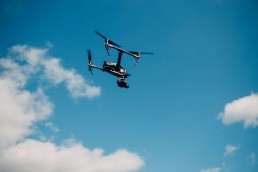Across Sweden, drone-based air mobility is entering a new phase. What has long been limited to isolated tests is now starting to take physical form, through new infrastructure, city-level pilots, and clearer pathways for integration. And while many challenges remain, the groundwork for regulated, large-scale drone use is beginning to take shape.
Kista Science City is part of that shift, working with partners to make drones a trusted part of everyday urban life.
Testing drones in real-world city settings
This autumn, a so-called drone-in-a-box system will be deployed in Stockholm. The trial in Farsta is part of CITYAM, an EU-funded project where the City of Stockholm, Kista Science City and other partners explore how drones can support public services in urban environments.
The drone-in-a-box — a remote-operable station that stores, charges, and launches a drone on schedule — will be used to collect traffic flow data via an onboard camera. But the test is as much about governance as it is about tech. It puts multiple systems to the test: airspace regulation, privacy, multi-agency coordination, and public acceptance.
Drones can’t simply be flown — they must be planned, approved, and trusted. In dense city settings, that need becomes even more critical due to regulatory complexity, risk mitigation, and the challenge of real-world integration. Projects like CITYAM are helping cities understand how that can be done safely and responsibly.
Sweden’s first droneport
On 10 June, Droneport Skellefteå officially opened — marking a milestone in how Sweden approaches drone integration. The facility is one of the world’s first dedicated drone airfields, with designated areas for takeoff, landing, and recharging. Its aim is to enable safe, repeatable drone operations for use cases like emergency response, medical logistics, and industrial transport.
Karolina Pamp from Kista Science City joined the inauguration panel to discuss how this kind of infrastructure changes the game: “This is a strong signal that Sweden is ready to move from individual tests to shared infrastructure. We’re seeing drones take a real step into public space — and that opens up new possibilities for cities, industry and emergency services alike. It also connects nicely to the drone work we’re doing in Kista, with new tests just around the corner.”
Internationally, only a few countries have taken this kind of step, and Sweden is now among them.
Building the conditions for broader use
Drone technology is well established, but integrating it into everyday urban life is not. That gap is no longer just about regulation or safety — it’s also about communication, coordination, and the ability to show who benefits and how. This is one of the key takeaways from projects like CITYAM, where tests are as much about governance as they are about the tech itself.
”The technology is already here. But until people understand what drones can actually do for them, progress will stay slow,” says Isabelle Nyroth, technical advisor at Kista Science City. ”We need examples that feel real and relatable. Otherwise, this risks becoming just another promising technology that never quite lands. The good news is we’re now starting to see those examples emerge — and when they do, they open people’s eyes to what’s possible.”
What’s next?
Routine drone operations won’t happen overnight. But Sweden is taking visible steps in that direction. As infrastructure emerges and urban pilots expand, the focus is shifting from proving the technology to proving the use cases — whether that’s monitoring traffic flows, transporting medical supplies, or supporting emergency services, to name a few.
That’s the next challenge for drone-based air mobility. Not just to fly, but to fit into the systems, rules, and realities that shape everyday life.
Get involved
Do you want to learn more or explore future collaborations? Reach out to isabelle.nyroth@kista.com
Related Articles
December 9, 2025
Understanding online risks: Lisa Kaati’s research at DSV in Kista
The boundaries of conflict are shifting. Today, national security isn’t just…




